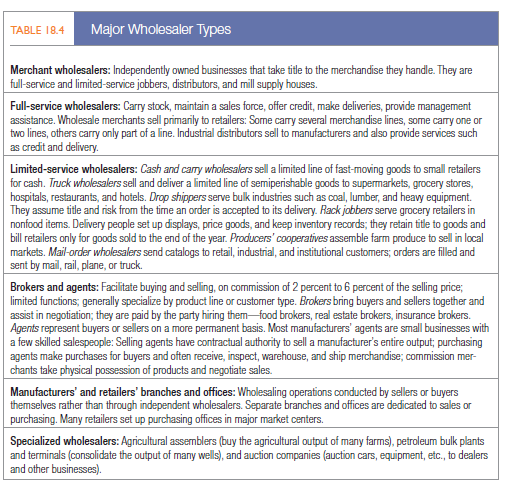Wholesaling includes all the activities in selling goods or services to those who buy for resale or business use. It excludes manufacturers and farmers because they are engaged primarily in production, and it excludes retailers. The major types of wholesalers are described in Table 18.4.

Wholesalers (also called distributors) differ from retailers in a number of ways. First, wholesalers pay less attention to promotion, atmosphere, and location because they are dealing with business customers rather than final consumers. Second, wholesale transactions are usually larger than retail transactions, and wholesalers usually cover a larger trade area than retailers. Third, wholesalers and retailers are subject to different legal regulations and taxes.
Why do manufacturers not sell directly to retailers or final consumers? Why use wholesalers at all? In general, wholesalers can more efficiently perform one or more of the following functions:
- Selling and promoting. Wholesalers’ sales forces help manufacturers reach many small business customers at a relatively low cost. They have more contacts, and buyers often trust them more than they trust a distant manufacturer.
- Buying and assortment building. Wholesalers are able to select items and build the assortments their customers need, saving them considerable work.
- Bulk breaking. Wholesalers achieve savings for their customers by buying large carload lots and breaking the bulk into smaller units.
- Warehousing. Wholesalers hold inventories, thereby reducing inventory costs and risks to suppliers and customers.
- Transportation. Wholesalers can often provide quicker delivery to buyers because they are closer to the buyers.
- Financing. Wholesalers finance customers by granting credit and finance suppliers by ordering early and paying bills on time.
- Risk bearing. Wholesalers absorb some risk by taking title and bearing the cost of theft, damage, spoilage, and obsolescence.
- Market information. Wholesalers supply information to suppliers and customers regarding competitors’ activities, new products, price developments, and so on.
- Management services and counseling. Wholesalers often help retailers improve their operations by training sales clerks, helping with store layouts and displays, and setting up accounting and inventory-control systems. They may help industrial customers by offering training and technical services.
1. TRENDS IN WHOLESALING
Wholesaler-distributors have faced mounting pressures in recent years from new sources of competition, demanding customers, new technologies, and more direct-buying programs by large industrial, institutional, and retail buyers. Manufacturers’ major complaints against wholesalers are: They don’t aggressively promote the manufacturer’s product line and they act more like order takers; they don’t carry enough inventory and therefore don’t fill customers’ orders fast enough; they don’t supply the manufacturer with up-to-date market, customer, and competitive information; they don’t attract high-caliber managers to bring down their own costs; and they charge too much for their services.
Savvy wholesalers have rallied to the challenge and adapted their services to meet their suppliers’ and target customers’ changing needs. They recognize that they must add value to the channel. Arrow Electronics has done just that.63
ARROW ELECTRONICS Arrow Electronics is a global provider of products, services, and solutions to the electronic component and computer product industries. It serves as a supply-channel partner for more than 100,000 original-equipment manufacturers, contract manufacturers, and commercial customers through a global network of 470 locations in 55 countries and territories. With huge contract manufacturers buying more parts directly from suppliers, however, distributors like Arrow are being squeezed out. To better compete, the company has embraced services, providing financing, on-site inventory management, parts-tracking software, and chip programming. Services helped quadruple its share price over a five-year stretch, and the company topped $21.4 billion in sales in 2013.
Wholesalers have worked to increase asset productivity by better managing inventories and receivables. They’re also reducing operating costs by investing in more advanced materials-handling technology, information systems, and the Internet. Finally, they’re improving their strategic decisions about target markets, product assortment and services, price, communications, and distribution.
Academic experts Jim Narus and Jim Anderson interviewed leading industrial distributors and identified four ways they strengthened their relationships with manufacturers:64
- They sought a clear agreement with their manufacturers about their expected functions in the marketing channel.
- They gained insight into the manufacturers’ requirements by visiting their plants and attending manufacturer association conventions and trade shows.
- They fulfilled their commitments to the manufacturer by meeting the volume targets, paying bills promptly, and feeding back customer information to their manufacturers.
- They identified and offered value-added services to help their suppliers.
The wholesaling industry remains vulnerable to one of the most enduring trends—fierce resistance to price increases and the winnowing out of suppliers based on cost and quality. The trend toward vertical integration, in which manufacturers try to control or own their intermediaries, is still strong.
Source: Kotler Philip T., Keller Kevin Lane (2015), Marketing Management, Pearson; 15th Edition.

I like this web blog so much, bookmarked.
There is noticeably a bundle to find out about this. I assume you made certain nice factors in options also.